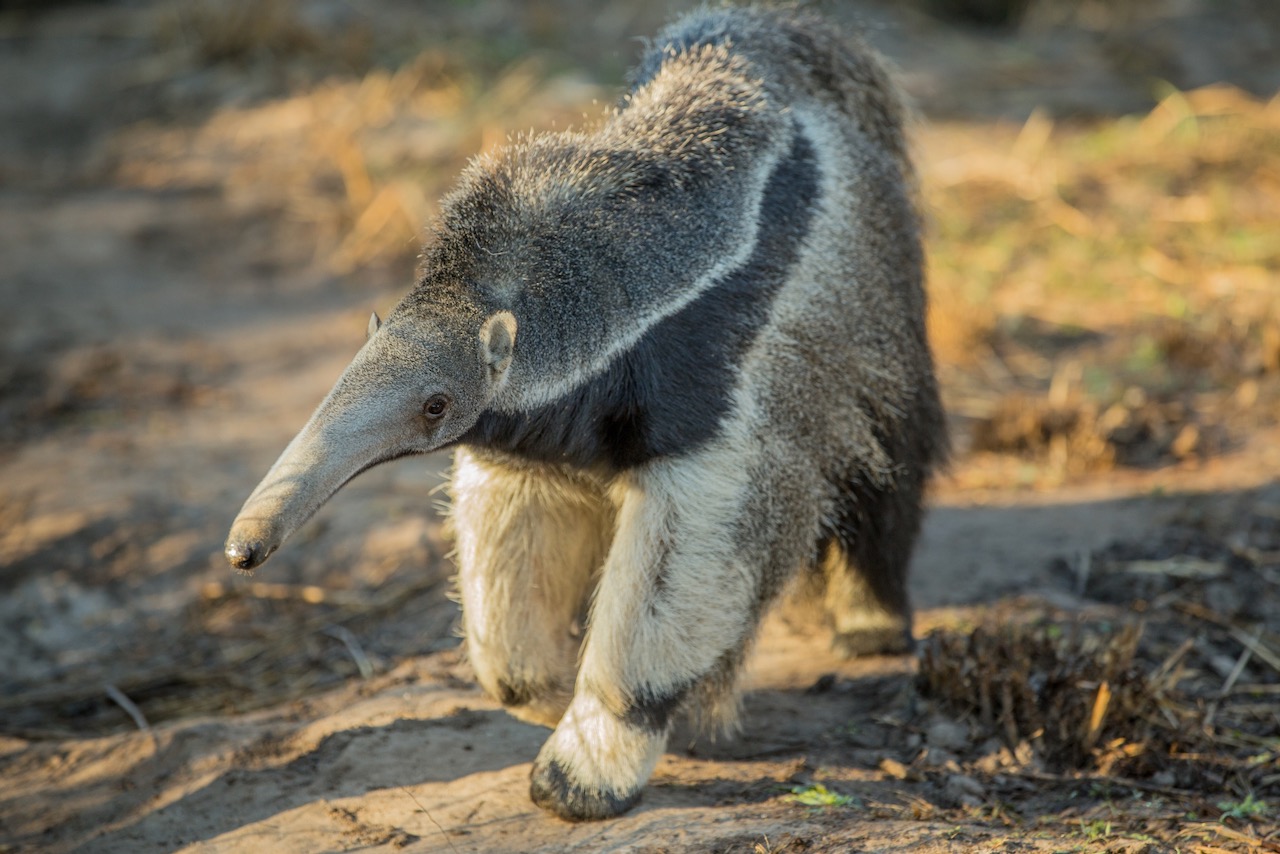Giant Anteater Returns to a Brazilian State 130 Years After Going Extinct

Photo documentation of a giant anteater in Rio Grande de Sul, Brazil, where the species went extinct, brings hope for the recovery of this large mammal. Experts believe that it dispersed from a growing population reintroduced by Rewilding Argentina in Iberá, a project whose benefits are already being observed beyond the limits of the park and Argentina. (Photo courtesy of Rewilding Argentina.)
Brazilian biologist Fábio Mazim was reviewing hundreds of hours of footage from camera traps for a wildlife survey in Espinilho State Park when he made the unexpected discovery of a giant anteater, a species which had gone extinct in the southwest of the state of Rio Grande do Sul over a century ago.
Fábio and his colleagues confirmed the incredible discovery with several videos over the course of six months. “The animal seems to be in very good condition and established in the area. At the moment it is impossible for us to determine if it is male or female, one or even several different individuals,” says Mazim. The next step for experts is to gather more data on the anteater and its dispersal.
According to Flavia Miranda, president of the Tamandua Institute, and a veterinarian who has been studying this species for more than 20 years, “It is almost certain that this animal has dispersed from the province of Corrientes, in Argentina, as part of the population reintroduced in the Iberá wetlands; the geographical proximity and the morphological characteristics we observed in the animal lead us to this conclusion.”
Rewilding Argentina, the offspring organization of Tompkins Conservation, made the first reintroduction of giant anteaters in Iberá Park in 2007. Its decline was due to widespread habitat loss from industrial agriculture and deforestation, hunting, and motor vehicle accidents. The rewilding program has since rescued and released 110 anteaters. Several generations now inhabit the wetlands. The documentation of the species’ dispersal over one hundred kilometers shows that Ibera’s growing population of giant anteaters is colonizing other regions, including Brazil.
According to Sebastian Di Martino, director of conservation for Rewilding Argentina, “Ibera went from a place of massive defaunation to abundance. Rewilding multiple species is making it once again a functional ecosystem. We hope that these results are inspiring for rewilding initiatives everywhere. Now, through natural dispersal or assisted translocation, Iberá can serve as a source of species for the greater region beyond Argentina experiencing massive biodiversity loss.”
Kristine Tompkins, president and co-founder of Tompkins Conservation, celebrated the news. “The discovery of this giant anteater in the Espinilho State Park demonstrates that the recovery of nature is possible through rewilding. We must remember that wildlife does not recognize borders and make every effort between countries to ensure the success of large-scale restoration initiatives.”
BACKGROUND
One of the most striking and peculiar mammals of Argentina, the giant anteater (Myrmecophaga tridactyla) has a long snout without teeth, and a very long tongue that it uses to obtain its primary food source: ants and termites. Anteaters only have one offspring per year, and are sensitive to human persecution as well as to habitat loss. Considered in danger of extinction in Argentina, giant anteaters were the first missing species that our wildlife team reintroduced in Iberá Park. Since the anteater reintroduction program’s launch in 2007, more than 100 anteaters orphaned by poachers or car accidents have been rescued and released in the wild. New local populations have been established and individuals have started dispersing beyond park boundaries.
Great Iberá Park is located in Corrientes Province in northeastern Argentina, comprised of the Iberá Provincial Park, of some 600,000 hectares, and the Iberá National Park, of 158,000 hectares, donated by Tompkins Conservation and Rewilding Argentina to the Argentine state. The wetlands occupy the center of a great subtropical plain surrounded by Paraná Atlantic forest, Chaco forest, open grasslands and thorny shrublands.
Rewilding Argentina is working to bring back a number of species that play a crucial role in the ecosystems of Iberá Park, among them the jaguar, pampas deer, giant anteater, giant otter, the red-and-green macaw, collared peccary and the bare-faced curassow. In parallel, the nonprofit has helped develop a regenerative economy of nature-based tourism, with 10 gateways to Iberá Park that offer visitor services and wildlife watching opportunities.
A driving force to curb the worldwide climate emergency and the biodiversity crisis, Tompkins Conservation protects, rewilds, and defends land and marine ecosystems in the Southern Cone through collaborating to create national parks and rewilding key species. Working with public and private partners, the organization has helped to create 13 national parks, protecting 14.5 million acres. The goal is to restore a healthy planet with big, wild, and connected landscapes where animals and plants can thrive. This also means helping to build robust communities that benefit from a healthy natural world.
Kristine McDivitt Tompkins and Douglas Tompkins (1943-2015) founded Tompkins Conservation after leading iconic American clothing brands—Kristine as longtime CEO of Patagonia Inc, and Doug as co-founder of The North Face and Esprit. Changing course in the early 1990s to focus on conservation, they became two of the most successful conservation philanthropists in history. After Doug lost his life in a tragic kayaking accident in 2015, Kristine has continued to build on their foundation. She is now the president of Tompkins Conservation and a UN Environment Patron of Protected Areas.
A 501(c)(3) public charity, Tompkins Conservation carries out conservation projects through the nonprofit network of Rewilding Chile and Rewilding Argentina.



Wonderful news! I had the great pleasure of visiting the Pantanal while living in Rio de Janeiro in 2008. Central and southern South America is on the cutting edge of successful wilderness coexistence from Brazilian poudadas to Argentine and Chilean national parks. The successes of Rewilding Argentina and Thompkins Conservation should be informing our own efforts to restore iconic jaguars, ocelots, and other species through the Mogollon Rim, Sky Islands, Chihuahuan Desert, and beyond.
Good news for a change! It’s very rare for ecological issues.